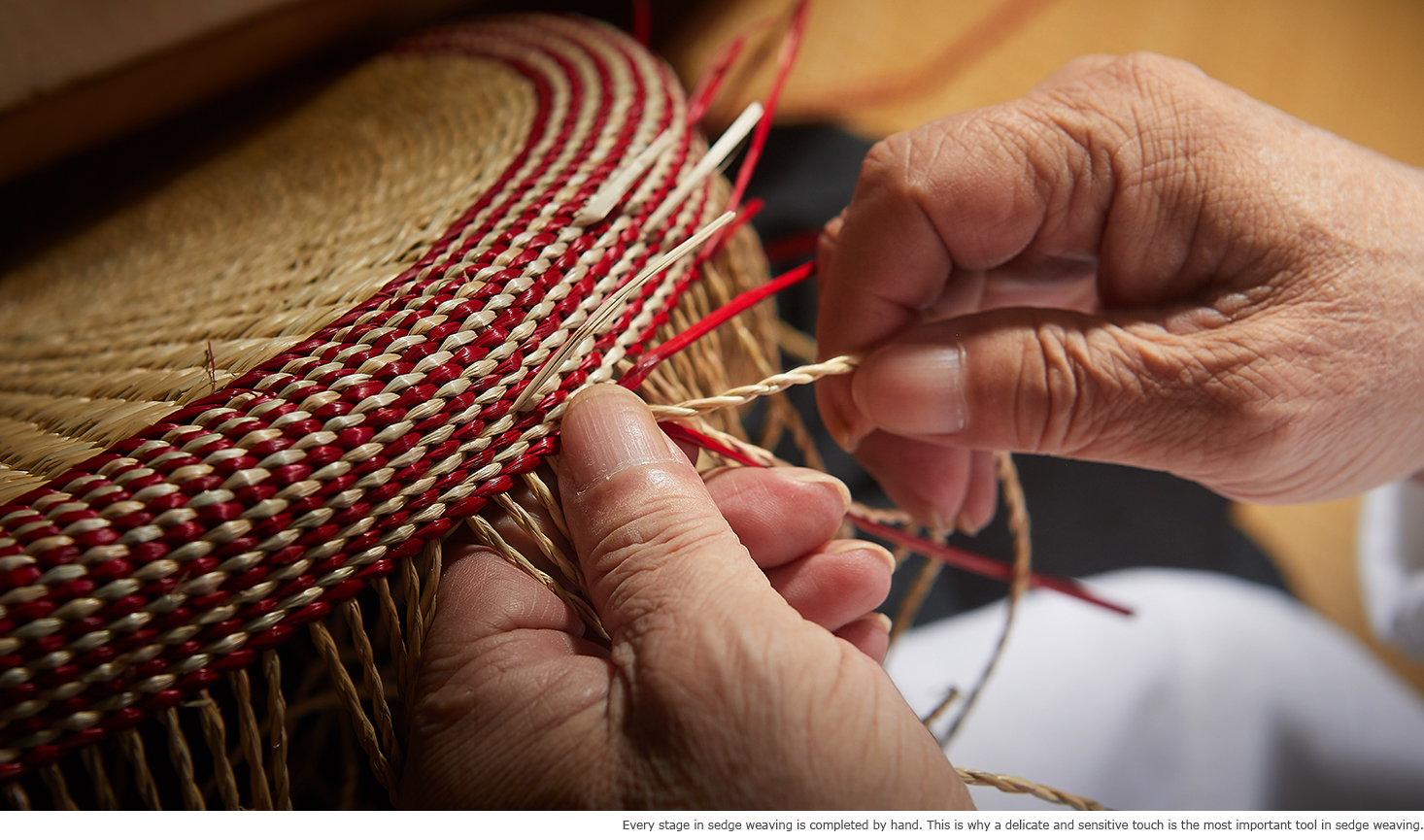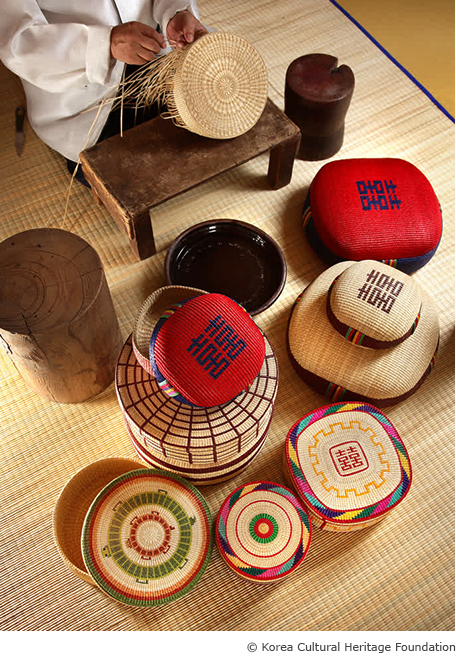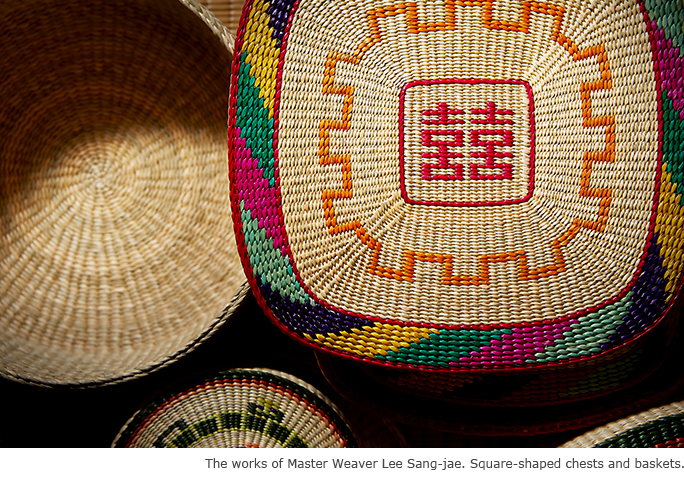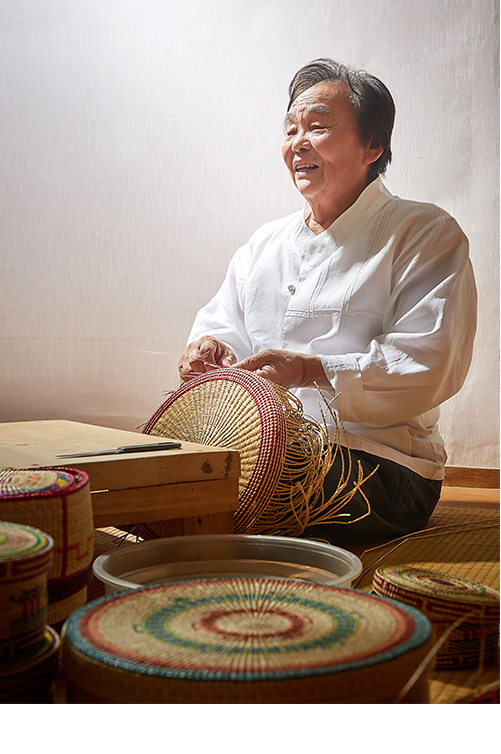
Contents





Master Weaver






The Weft and Warp of
Traditional Sedge, Rush Weaving
Master Weaver Lee Sang-jae
Lee Sang-jae is the bearer of National Intangible Cultural Heritage Item No. 103 and is a master of weaving using sedges, rushes and reeds, a wanchojang (완초장 ). He was born in Ganghwa-gun, Incheon Metropolitan City in 1943. His grandfather and mother had been making sedge and reed products as a source of side income since before he was born. The reed or sedge products made by Lee’s grandfather and mother during colonial times were once purchased by a Presbyterian minister stationed to Korea, and then sent onward to the U.K. Lee Sang-jae naturally began to learn the art of weaving with sedges, rushes and reeds from his family after finishing elementary school.
Written by Lee Hye-min, Editor Photographed by Studio Kenn

Destined to be a Master Weaver
Gyodongdo Island in Ganghwa-gun County, in the mouth of the Hangang River, is home to a small village with unfavorable soil conditions for rice farming. Thus, sedges and reeds have long been the key agricultural products of this community. Almost all of the residents made ends meet by weaving sedges, rushes, reeds and canes. This was also the case for Lee Sang-jae’s family, who began making sedge and rush products before he was even born. The sedge plant was a familiar presence in Lee’s life as a young boy. He officially entered the world of “sedge crafts” at the age of 14. At the time, sedge crafting was such a popular industry that young people started working as craftsmen instead of continuing at school. Lee learned more advanced techniques, such as making round box trios and seat cushions, from craftsman Yu Hyeong-shik, an elder in the village. In just three years after he started learning from his mother, he was recognized as the most skilled sedge weaver in the region, coming in first place in the annual Wanggol Competition. This was the beginning of Lee Sang-jae’s reputation as the definitive master of sedge weaving.
Sedge weaving, which primarily involves the hands, was the best way for Lee to develop his skills and to express himself, as childhood polio had left him with limited mobility. He enjoyed sitting down and concentrating on a given task. He played a decisive role in making hwamunseok patterned mats, which became a specialty of the Ganghwado region. Although the popularity of this product has dropped these days, hwamunseok mats were an essential home furnishing product that created a cool seating area in the summer. Furthermore, hwamunseok mats have a beautiful decorative effect, being made from sedge dyed various colors. This aesthetic effect is why the word hwa in hwamunseok means “flower.”
Lee started teaching sedge weaving as a boy craftsman not long after he became a wanchojang master weaver. Although he started by giving lessons to his fellow villagers, news of his talent spread far and wide, with numerous students travelling long distances to learn from him. One of these students became his current wife, Yu Seon-ok. Yu came to learn sedge weaving from Lee Sang-jae after graduating from Gyodong Elementary School, but fell in love with Lee and his outstanding talent. Just like the weft and warp of his craft, his life and sedge weaving are inseparable, woven together into a whole.
* The words wancho (완초) or wanggol (왕골) refer to certain varieties of sedges, canes and rushes, and a wanchojang (완초장), therefore, refers to a master craftsman who makes various products from those plants, such as mats, seat covers or boxes.

Natural Beauty Created by
Perfect Craftsmanship
Sedge and rush farming begins in April by preparing the seedbed and sowing the seeds. The seedlings are then moved to a field one month later, where the tedious work of weeding and fertilizing continues. Even after the sedge and rush is harvested in July or August, much work lies ahead. First, the stems have to be sliced with a knife to make strands, which are steamed and then dried completely over many months. Then they are exposed to dew and dried under the sun repeatedly over five to six days. Only after this long process does the sedge take on a waxy sheen, making it suitable to weave into products. Every stage in sedge weaving is completed by hand. This is why a delicate and sensitive touch is the most important tool in sedge weaving. Of course, there are steps that cannot be completed solely with the bare hands and require the assistance of tools. However, tools are only secondary in this craft.
The basic tools used in sedge weaving include the galgurakji wooden hook, the golmangchi wooden hammer, the goltomak wooden board, a rectangular frame and a skewer. The wooden hook is used to make the warp. The sedge strands are hooked onto the wooden hook, to be twined together. The wooden hammer is used to prevent irregular bumps and to fill the gaps between the sedge strands in the final product. The wooden board is used mainly to support the product when it is hit with the wooden hammer, and is usually made from persimmon tree wood. The rectangular frame is used to raise the edges in a rectangular shape when making rectangular products. The skewer is used to push the remaining eight warp ends inside after the product is completed.

Lee Sang-jae’s sedge products have been hailed as nothing less than perfect. The woven strands of sedge are very even, creating an orderly and elegant look. The composition of patterns featuring text, flowers or cranes is very natural. In particular, his technique of matching the length of the strands so that the ends meet in a perfect seam when they are pushed in is said to be beyond compare.
Currently, Lee makes a wide range of products from sedge and rush. These include traditional flowered box trios, baskets and regular boxes, as well as more contemporary items such as hats, bags, shoes and mobile phone accessories. However, Lee shows special affection for wicker chests used in certain wedding rituals. These baskets are technically challenging to make, but are highly sought after.
Choosing Spiritual Wealth Over
Material Wealth
Sedge weaving became an endangered art form when the traditionally high demand dropped off. At the height of its popularity in the 1970s, Lee worked to spread sedge weaving techniques and production across the country, to Seoul and Busan. However, the epoch was short lived, as the introduction of new materials led to a sharp decline in demand for sedge weaving. Furthermore, an influx of cheaper sedge products began, leading to a crisis threatening the very heart of traditional sedge weaving.
“Nobody wants to do this. People only want to do things that can make money. What can I do? Such are the times in which we live,” the master craftsman laments haplessly. However, he cannot help but show concern for the future of his traditional art, adding, “It’s regrettable.
I wish they would understand that if your life is filled with pride, you’ll not be shaken by the sight of others with overflowing material wealth. This is how we should bring together the value of traditional and modern ways of life.” Lee Sang-jae is Korea’s only wanchojang master sedge weaver and has been designated as a bearer of an Important National Intangible Cultural Heritage Item. “When I was designated as such, it felt like I had been given the whole world. However, the joy didn’t last. As time went by, the weight on my shoulders to carry on the tradition of sedge weaving felt heavier and heavier. I don’t have much time left,” Lee says.
He feels more responsibility than pride as a master sedge weaver. He’s more focused on ensuring the continuation of sedge weaving, rather than any pressure to “do well.” He tries to promote the art of sedge weaving by participating in efforts hosted by cultural organizations to keep traditional arts alive, and to raise awareness of sedge weaving using his name.
This is why Lee still cannot give up weaving, even after 60 years of dedication to the art form. Perhaps this dedication to this tradition was considered, alongside his talent, in his designation as a bearer of an Important National Intangible Cultural Heritage Item.


Thanks to sedge weaving, he was able to forget his physical impairment and even meet his wife, who respects him more than anyone else in the world. Now his daughter is a practitioner of sedge weaving, a fact that brings a smile to her father’s wrinkled face. Lee takes greater pride in his title of wanchojang master sedge weaver, and values it more than any material item the world could possibly give him. Even after experiencing numerous challenges in the survival of sedge weaving, he doesn’t give up hope, saying that there is greater appreciation for arts, heritage and tradition these days. He forgoes decorative accessories of any kind for himself, choosing to hide behind the beauty of his craft. Lee Sang-jae is the highly-respected, sole bearer of the wanchojang master sedge weaver designation, Important National Intangible Cultural Heritage Item No. 103.
-
Lee Sang-jae Profile
 1963grand prize at the Ganghwa Folk Handicrafts Competition
1963grand prize at the Ganghwa Folk Handicrafts Competition 1964gold prize at the Gyeonggi-do Folk Handicrafts Competition
1964gold prize at the Gyeonggi-do Folk Handicrafts Competition 1994special selection at the 24th National Handicrafts Competition
1994special selection at the 24th National Handicrafts Competition 1996recognized as a wanchojang master sedge weaver and bearer of Important National Intangible Cultural Heritage Item No. 103
1996recognized as a wanchojang master sedge weaver and bearer of Important National Intangible Cultural Heritage Item No. 103 2002received medal from Incheon Metropolitan Government
2002received medal from Incheon Metropolitan Government 1999-2003judge at various competitions, such as the Incheon Metropolitan Competition, Ganghwa Handicrafts Competition and the Hwamunseok Mat Design Competition
1999-2003judge at various competitions, such as the Incheon Metropolitan Competition, Ganghwa Handicrafts Competition and the Hwamunseok Mat Design Competition 1996to present, participation in intangible cultural heritage bearer exhibitions and educational activities
1996to present, participation in intangible cultural heritage bearer exhibitions and educational activities
Other Articles





Master Weaver




in Korea

Application of subscription
Sign upReaders’ Comments
GoThe event winners
Go


 July 2018
July 2018





